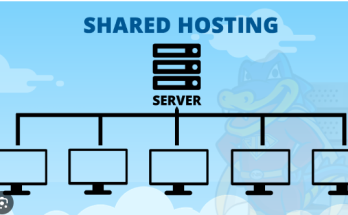Introduction
In the vast digital landscape, web hosting plays a crucial role in establishing an online presence. Understanding what web hosting is and how it functions is fundamental for anyone venturing into the realm of creating a website.
What is Web Hosting?
At its core, web hosting is a service that enables individuals and organizations to make their websites accessible via the World Wide Web. It involves the allocation of space on a server, where website files, data, and content are stored, ensuring they are accessible to users surfing the internet.
Types of Web Hosting
- Shared Hosting:
- Perfect for beginners and small websites, shared hosting involves multiple websites sharing resources on a single server.
- VPS (Virtual Private Server) Hosting:
- Offers a middle ground between shared and dedicated hosting, providing a virtual server environment with allocated resources.
- Dedicated Hosting:
- Reserved for high-traffic websites, this type provides an entire server exclusively for one website, offering maximum control and customization.
- Cloud Hosting:
- Utilizes multiple interconnected servers to handle traffic spikes and ensure website uptime, offering scalability and flexibility.
- Reseller Hosting:
- Allows individuals to resell hosting services, acting as their own hosting company.
Key Components of Web Hosting
- Server:
- The hardware where all website files, databases, and content are stored.
- Control Panel:
- Interface allowing users to manage their hosting account, domains, emails, databases, and more.
- Bandwidth:
- The amount of data that can be transferred between a website, its users, and the internet.
- Storage:
- The disk space provided by the hosting service to store website files, images, videos, and other content.
- Uptime and Reliability:
- Crucial factors ensuring your website remains accessible and operational most of the time.
How to Choose the Right Web Hosting Provider
- Assess Your Needs:
- Understand your website’s requirements in terms of traffic, resources, and scalability.
- Consider Features:
- Look for essential features like SSL certificates, customer support, backup services, and ease of use.
- Compare Plans:
- Evaluate different hosting plans based on pricing, resources offered, and customer reviews.
- Check Customer Support:
- Reliable and responsive customer support is invaluable, especially during technical issues.
Conclusion
In conclusion, web hosting is the cornerstone of your online presence. Choosing the right hosting provider and plan tailored to your website’s needs ensures a smooth and efficient online experience for you and your visitors.
Title: Understanding Web Hosting: A Comprehensive Guide
Introduction
- Definition of Web Hosting: Begin by defining what web hosting is. Explain that web hosting is a service that allows individuals or organizations to make their website accessible via the World Wide Web. It involves storing website files on a server connected to the internet.
Section 1: Types of Web Hosting
- Shared Hosting: Explain shared hosting where multiple websites share resources on a single server. Highlight its affordability but also mention potential limitations.
- VPS Hosting: Describe Virtual Private Server (VPS) hosting, which offers more control and resources than shared hosting. Explain its scalability and benefits for growing websites.
- Dedicated Hosting: Discuss dedicated hosting where users have an entire server exclusively for their website. Highlight its high performance and customization options.
- Cloud Hosting: Explain cloud hosting and its scalability by using multiple servers. Discuss its flexibility and reliability.
Section 2: Key Features of Web Hosting
- Storage: Explain the importance of storage space for hosting files, images, and databases.
- Bandwidth: Describe bandwidth and its significance in handling website traffic.
- Uptime and Reliability: Discuss the importance of uptime in web hosting and how reliable servers contribute to a website’s accessibility.
- Security: Discuss security measures provided by hosting companies to protect websites from cyber threats.
- Customer Support: Explain the significance of responsive and knowledgeable customer support in web hosting services.
Section 3: Factors to Consider When Choosing a Web Host
- Performance: Discuss how a hosting provider’s performance affects website speed and user experience.
- Scalability: Explain the importance of scalability for websites expecting growth in traffic and content.
- Cost: Analyze various pricing models and discuss factors that influence the cost of web hosting.
- Customer Reviews and Reputation: Highlight the importance of researching reviews and a hosting provider’s reputation before making a decision.
- Additional Features: Discuss additional features like backups, SSL certificates, and one-click installations offered by hosting providers.
Section 4: How to Choose the Right Web Hosting Plan
- Assess Your Needs: Guide readers on how to evaluate their website requirements in terms of traffic, content, and future growth.
- Research Hosting Providers: Provide tips on researching and comparing different hosting providers based on features and pricing.
- Consider Technical Requirements: Discuss technical aspects such as server location, server resources, and CMS compatibility.
Conclusion
- Summarize the importance of selecting the right web hosting plan tailored to the specific needs of a website. Encourage readers to conduct thorough research before making a decision. Emphasize the significance of reliable web hosting in the success of an online presence.
What Is Web Hosting? A Comprehensive Guide
In the expansive realm of the internet, web hosting is the cornerstone that enables websites to exist and be accessible to users worldwide. It’s the process of providing storage space and access for websites and web pages on servers that are continuously connected to the internet.
1. Understanding the Basics of Web Hosting
Web hosting involves storing website files, data, and content on servers. These servers are powerful computers designed to handle requests from users accessing your website.
2. Types of Web Hosting
- Shared Hosting: Multiple websites share resources on a single server.
- VPS (Virtual Private Server) Hosting: Divides server resources into virtual servers, offering more control and flexibility.
- Dedicated Server Hosting: Provides exclusive use of an entire server for one website or client.
- Cloud Hosting: Utilizes multiple servers to create a ‘cloud’ to host websites, ensuring reliability and scalability.
3. Key Components of Web Hosting
- Server: The physical hardware that stores website data and files.
- Bandwidth: The amount of data transferred between the server and users accessing the website.
- Uptime: The time during which a server is operational and accessible. It’s crucial for website availability.
- Security: Measures taken to protect websites from cyber threats and data breaches.
4. Factors to Consider When Choosing a Web Host
- Performance: Speed, uptime, and server reliability are pivotal for user experience and SEO.
- Scalability: The ability to accommodate website growth and increased traffic.
- Support: 24/7 customer support can be crucial for troubleshooting issues.
- Security Measures: SSL certificates, backups, and firewalls for enhanced security.
5. Steps to Set Up Web Hosting
- Choose a Hosting Provider: Select a provider that aligns with your website’s needs.
- Select a Hosting Plan: Decide on the type of hosting that suits your requirements.
- Register a Domain: Choose and register a unique domain name for your website.
- Set Up and Configure: Follow the hosting provider’s instructions to set up your hosting account.
- Upload Your Website: Transfer or build your website on the hosting server.
6. Managing Your Web Hosting
- Regular Backups: Create and maintain backups to prevent data loss.
- Monitoring Traffic and Performance: Use analytics tools to track website performance and user behavior.
- Update Software and Security: Keep software, plugins, and security measures up to date to fend off vulnerabilities.
7. Common Challenges and Solutions
- Slow Loading Speed: Optimize images, utilize caching, and choose a reputable hosting provider.
- Security Breaches: Implement robust security measures and regularly update software.
- Downtime: Choose a reliable hosting provider with excellent uptime guarantees.
Conclusion
Web hosting forms the backbone of every successful website. Understanding its nuances and selecting the right hosting solution for your needs is pivotal for a seamless online presence. By grasping the fundamentals and considering various factors, you can ensure your website remains accessible, secure, and efficient for its intended audience.



